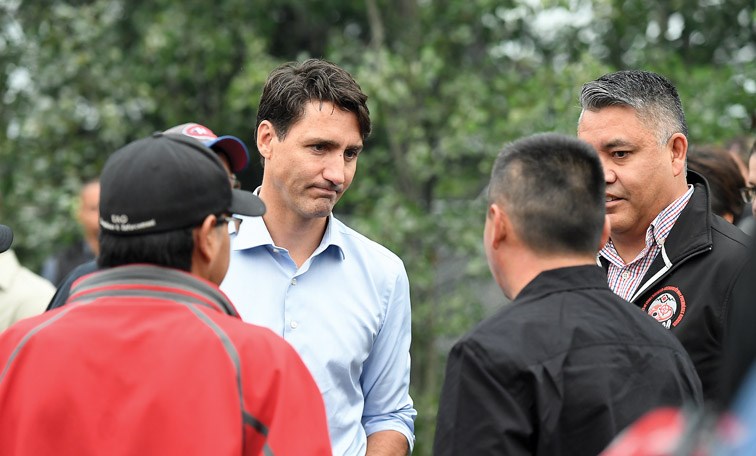The Central Interior's wildfire crisis brought Prime Minister Justin Trudeau to the area on Thursday.
Few sitting prime ministers have visited Prince George for any reason. This time, there was a strong public call for Trudeau, who was in B.C. anyway for cabinet meetings. Premier John Horgan came for a tour of the incident response activities on Tuesday accompanied by federal defence minister Harjit Sajjan.
The first thing Trudeau did was attend a briefing at the region's emergency fire centre on Opie Crescent. Five leaders of the fire suppression effort gave reports to the Prime Minister and a number of other elected officials from the broader region.
"Thank you for making it possible for me to come here. I absolutely don't want to disrupt anything," Trudeau told those in the conference room, "but I want to be able to thank everyone for the work they're doing and see and make sure everyone is collaborating well, as I know they are."
Following the information session, Trudeau and the other officials attended a breakfast where a number of volunteers and firefighting personnel were the guests of honour.
"I know this has been a long season, a lot of work," he addressed them directly, adding that he understood how there are "folks worried about their homes, worried about their livelihoods, scared. The way leadership has come together, all the organizations, the volunteers, the firefighters, is really amazing."
He said the conversation is in some ways a repeat of last year, referencing the worry and effort over towns like Williams Lake.
Horgan called B.C.'s repetitious experiences with crisis-level wildfires to be
"the new normal," and Trudeau echoed that on Thursday referring to "this new reality" that is, looking towards the future "requiring us to really reflect on how we can work together better, how we can support each other."
Two primary criticisms have emerged from this year's fire events.
One is how some homeowners in danger of losing their homes, businesses, farms even entire communities, have expressed a range of strong emotions over perceived disorganization by firefighting management. That includes a lack of communication with homeowners in danger even when the flames are getting close.
Part of that disconnection is how First Nations are under federal jurisdiction for emergencies while non-First Nations are provincial jurisdiction. Sometimes the difference is two sides of the same road.
Trudeau was asked if more money was coming for First Nations. He replied, "You fight fires with equipment; you fight fires with personnel. That's the work we're doing right now."
He indicated two of this area's leading Aboriginal leaders in attendance at his visit, Grand Chief Ed John (Akile Ch'oh) of the First Nations Summit and a hereditary chief of the local Tl'azt'en First Nation; and Carrier Sekani Tribal Council chief Terry Teegee, the regional chief for the British Columbia Assembly of First Nations. Trudeau said dialogue with Aboriginal communities has been and would continue to be ongoing, and the input of Teegee and John was actively sought during this current calamity.
"We have to clear up those lines of flowing resources and ensuring people get what they need regardless of whether they're in an Indigenous community or a non-Indigenous community. We need to ensure people are safe and that homes and livelihoods are protected. We've made significant improvements, but as you point out, there is still lots more to do."
The Citizen asked Trudeau if firefighting in the forest might best be coordinated federally, since the military has had to intervene twice now in successive years in B.C. alone. The second of the two major criticisms emerging out of endangered communities is how the response to fires is, on the whole, too slow and too small.
"The provincial firefighting, wildfire, authorities, particularly here in B.C., are extraordinarily capable, extraordinarily good at their job," he said. "The federal government is always there to support when necessary. Often that's not necessary. It only becomes necessary at a certain point. There is always more we should be looking at: better integration, better allocation of resources, better coordination to make sure that what is need is there at a given moment. People don't really care if it is federal help, municipal help, provincial help, they just want to see the help at the right time in the right way."
Trudeau said each year was bringing emergency responders new information and deeper experiences. That was especially important because forest fires are not behaving in modern times as they once did. Firefighting had to be re-learned to "adjust to what is unfortunately a new reality of more extreme weather events across the province, across the country, and around the world."
What hasn't changed is the public's commitment to neighbours and even strangers.
"We're Canadians. We're there for each other; we lean on each other," he said. "Obviously our hearts go out to them (who have lost homes and other values). What Canadians do is we stick up for each other in times of difficulty. I know the outpouring of support last year, and again this year. We are all heartbroken at the extraordinarily difficult situation people are going through. I mean, people have lived in these communities for generations, for millennia in the case of Indigenous communities, and there is a deep attachment. When you're watching your entire livelihood and perhaps your kids' future going up in smoke, that's an extraordinarily difficult thing... We will figure out how to move forward, how to rebuild."



